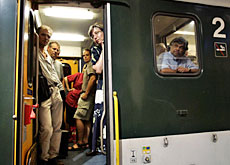Railway bosses learn lessons from power cut

The Swiss Federal Railways is implementing a series of measures in the wake of a short circuit which caused a collapse of the entire network in June.
The railway board said mistakes had been made but it confirmed senior managers would remain in their posts.
It ordered an additional external audit in an effort to establish whether further steps are needed to improve the power grid.
The report by the Federal Railways published on Monday said the short circuit on June 22 was the result of “an unfortunate chain reaction caused by separate incidents”.
It began with wrong data about the capacity of a power line in central Switzerland, which led to an erroneous risk assessment, said Thierry Lalive d’Epinay, chairman of the board of the Federal Railways.
He added that the railway management had never considered a short circuit on a national scale as a worst-case scenario.
Lalive d’Epinay said it would have been possible to avoid the shutdown because there was enough electricity in the grid.
New measures
Railways chief executive Benedikt Weibel said the company had taken 20 steps in a bid to avoid a repeat of the June 22 incident which left 200,000 passengers stranded on about 2,000 trains across the country.
The measures envisaged at short notice include a 50 megawatt increase in the electricity reserves, a review of the checklists and improvements of the training of staff.
The company is also considering a capacity increase in the power grid at a cost of SFr1.25 billion ($985 million) by 2020.
However the railway board stopped short of dismissing Weibel or any other senior managers.
swissinfo with agencies
The short circuit on June 22 left about 200,000 passengers stranded on 2,000 trains.
The cost of the short circuit is estimated at SFr5 million.
The Swiss Federal Railways transports 700,000 passengers on 9,000 trains every day.
There are also 2,200 daily goods trains carrying 160,000 tons of merchandise.
The Swiss rail network, including private companies, is 5,100 kilometres, one of the densest in the world.

In compliance with the JTI standards
More: SWI swissinfo.ch certified by the Journalism Trust Initiative










You can find an overview of ongoing debates with our journalists here . Please join us!
If you want to start a conversation about a topic raised in this article or want to report factual errors, email us at english@swissinfo.ch.